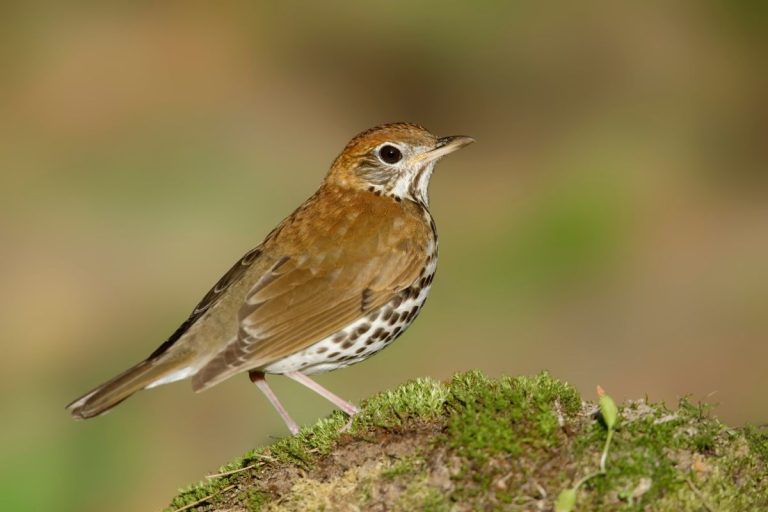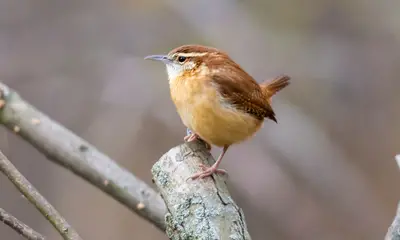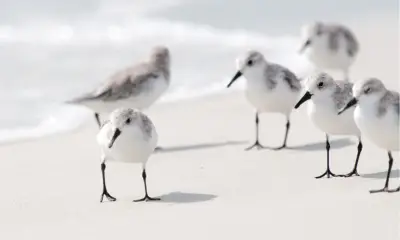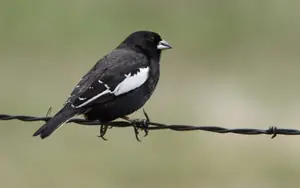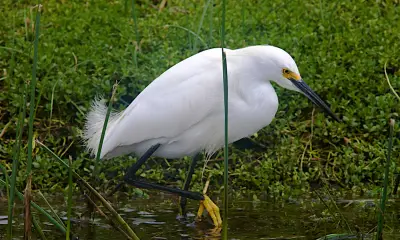21 Common LARGE BIRDS In Florida (ID Guide With Photos)
Did you recently come across a large bird in Florida, and want to know what species it was?
Identifying big birds in Florida is not as easy as it might seem, since there are more than 20 bird species in Florida that are on the large side.
To help you identify the bird you saw, we’ll cover the most common large birds of Florida in this article.
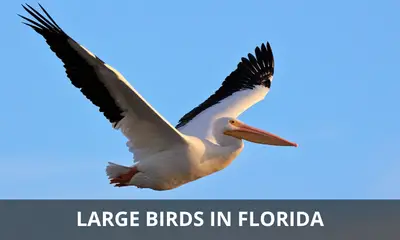
What are the types of large birds in Florida?
The 21 types of large birds that can be seen in Florida are:
- Great Egret
- Great Blue Heron
- White Ibis
- Roseate Spoonbill
- American Flamingo
- Double-crested Cormorant
- Brown Pelican
- American White Pelican
- Caspian Tern
- Snowy Egret
- Common Loon
- Wood Stork
- Whooping Crane
- White-tailed Kite
- Swallow-tailed Kite
- Great Black-backed Gull
- Osprey
- Bald Eagle
- Turkey Vulture
- Great Horned Owl
- Red-tailed Hawk
While many of these birds are year round residents of Florida, others only occur in the state during the winter, as migratory birds that spend the cold months in Florida.
Yet other birds are summer visitors during the breeding season, and some are scarce vagrants that are rarely seen in the state (more on that below).
Now let’s dive into the details, and take a closer look at each of these species in order to get the full scoop:
Great Egret
Scientific name: Ardea alba
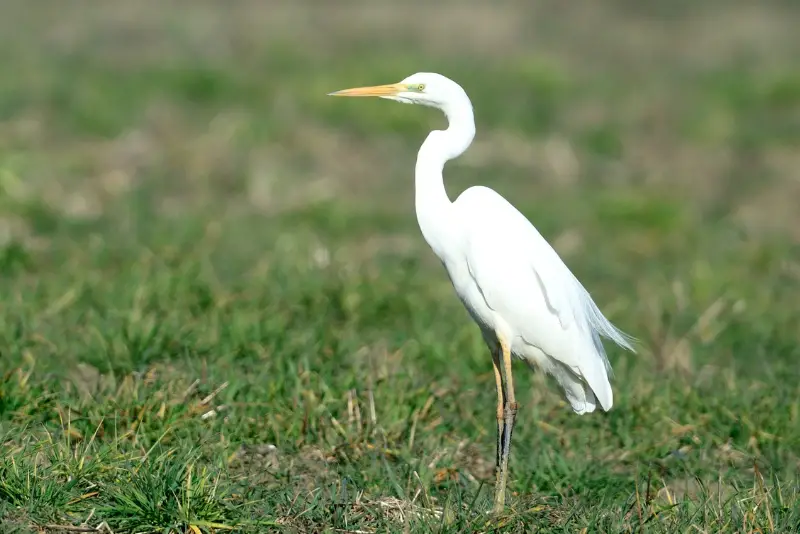
The Great Egret has a range that spans nearly the whole planet, and can be found on almost all continents.
This heron is one of Florida’s biggest birds that is a year-round resident. It is all white, and has long black legs and feet along with a thick, yellow bill.
During the spring and summer breeding seasons, the Great Egret grows a plume on its back that extends all the way to the tip of its tail.
It lives in both saltwater and freshwater habitats in Florida, and often nests in large colonies on the banks of marshes, lakes, and rivers.
Great Egrets forage in any type of shallow water in Florida, including ponds, lakes, rivers, estuaries, as well as rice fields and other flooded areas.
It is especially prevalent in the eastern and central regions of the state throughout the summer.
Outside of the breeding season it is less common, but where it occurs it can be seen in large flocks.
This species is one of the many white birds commonly found in Florida.
Great Blue Heron
Scientific name: Ardea herodias
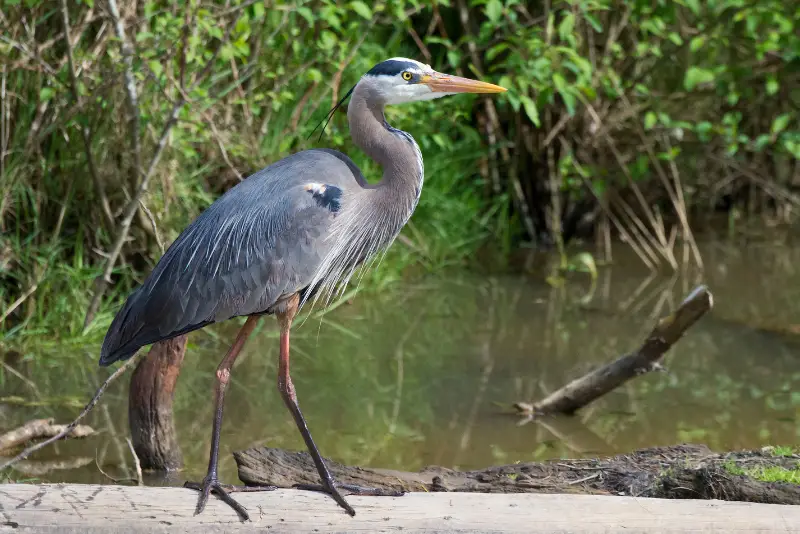
The Great Blue Heron is one of the most common herons in Florida, where it can be seen year round.
With a wingspan of up to 6 feet, this heron is one of Florida’s largest birds. It is almost entirely blue gray, except for a white throat and eye stripe, as well as dark gray wing feathers.
This enormous blue bird in Florida likes to hunt for small fish by wading in the shallows of estuaries, mud flats and marshes along the seaboard.
It waits patiently for a suitably sized fish to come close enough to be grabbed with its long, yellow bill.
The Great White Heron is an all-white shore bird that breeds in Florida Bay, and until recently it was thought that it is a subspecies of the Great Blue Heron.
However, recent evidence suggests that the Great White Heron is actually a distinct species.
White Ibis
Scientific name: Eudocimus albus
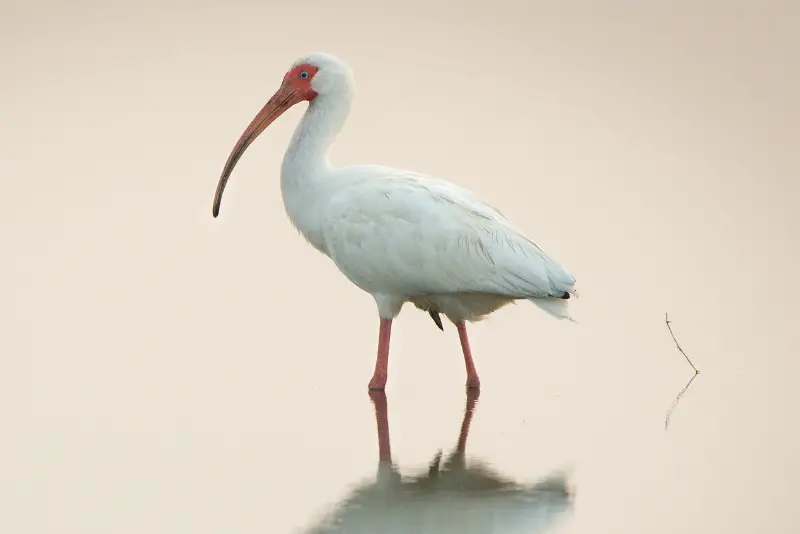
This species is easy to recognize due to its entirely white plumage and long orange beak that is curved downwards.
The black wing tips are not really apparent until it takes to the wing.
During the first two years of their lives, immature White Ibises have a chocolate brown body with light streaks and a pale orange beak.
While it is most commonly found in coastal areas of Florida, the White Ibis prefers to forage in freshwater habitats.
This Florida bird feeds on fish, insects, crayfish, and other crustaceans. Crayfish form a large part of its diet in areas where they are common.
They nest in large colonies in Florida forests located close to wetlands. These birds are extremely social, and like to forage in groups of 20 birds or more. In fact, it’s rare to see a solitary White Ibis.
Roseate Spoonbill
Scientific name: Platalea Ajaja
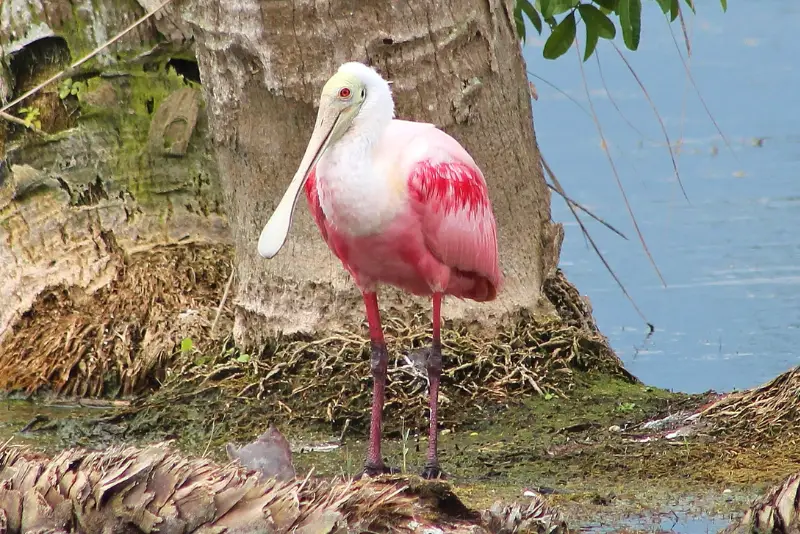
Roseate spoonbills are wading birds in Florida, similar to storks but slightly smaller. The adults are white on their backs, neck, and face, while the rest of their plumage is bright pink.
The Roseate Spoonbill is a large pink bird that can be seen in Florida coastal areas. However, the exact shade of pink can vary a lot, depending on its diet.
The more shrimp it eats, the more pink its plumage becomes, due to the carotenoid substances found in shrimp.
These birds are sometimes mistaken for flamingos because they look similar, but keen ornithologists will notice that flamingos have a short, angled bill, while spoonbills have a long, spatulate bill that has a broad “spoon” at its end.
This is the most common pink bird in Florida. The best place to see these gorgeous birds in Florida is in the Everglades, which has more than 200 breeding pairs.
American Flamingo
Scientific name: Phoenicopterus ruber
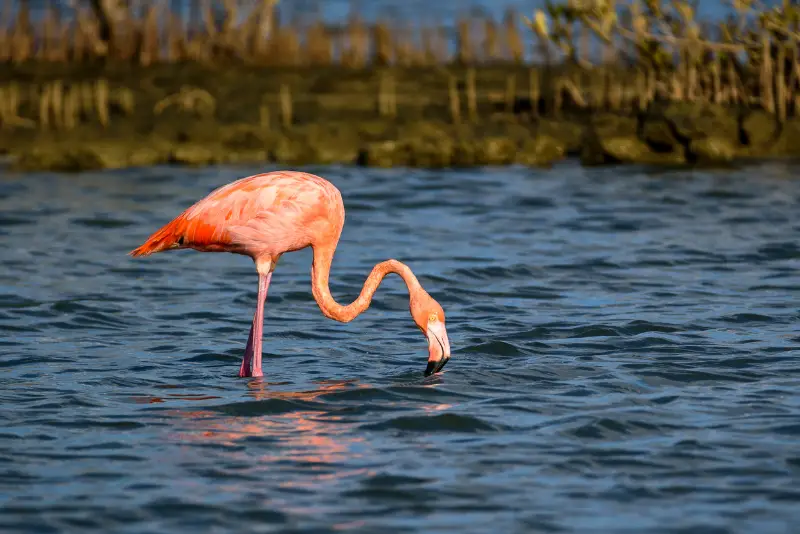
The American Flamingo is a member of the flamingo family, Phoenicopteridae, that is found in North and South America.
When it comes to Florida, no bird species is more synonymous with the culture of the state than the flamingo, which is somewhat ironic, given that it is not native to Florida.
Somewhat stereotypically associated with Miami, the American Flamingo is found along the coasts of the Caribbean, the Gulf of Mexico, as well as northern parts of South America.
It is thought that the population of American Flamingos is descended from birds that escaped from parks and zoos. It is most often seen in the Everglades and other areas with salt flats.
Double-crested Cormorant
Scientific name: Phalacrocorax auritus

The Double-crested Cormorant is a large, dark waterbird with a long neck and blue eyes. It is a year-round resident in Florida, and is commonly found on coastal waters.
This cormorant likes to gather in large flocks that roost on trees close to water. It is a skilled diver and hunts fish with its large, hooked bill.
When a group of cormorants flies together, they like to form up in a V shaped formation.
Often these V-shaped formations can be seen in the evening, when the birds fly to their roosting spots in Florida.
Brown Pelican
Scientific name: Pelecanus occidentalis

Brown Pelicans are the most common pelicans found in Florida, where they hunt fish by plunging head-first into the water.
Adult Brown Pelicans are grayish brown with a dark belly, and can be easily recognized by their massive bill.
While this pelican species was endangered a few decades ago due to pesticide poisoning, it has now recovered and is once more a common breeding bird and year-round resident in the state.
American White Pelican
Scientific name: Pelecanus erythrorhynchos

The American White Pelican is the biggest bird in Florida, and is a lot bigger than the Bald Eagle.
It is almost entirely white, except for black primary and secondary feathers on its wings.
Its huge beak is bright orange, and has a flat plate protruding from the upper part of the beak during the summer breeding season.
Outside of the breeding season, the bill changes its color from orange to pale yellowish.
American White Pelicans are observed in Florida during the winter months, as they make Florida their home during the cold season.
Its preferred habitat in Florida are estuaries, shallow bays, and coastal inlets, as well as freshwater lakes further inland.
This bird feeds almost exclusively on fish, but unlike other pelican species it doesn’t dive in order to catch them. Instead it submerges its head down into the water, and grabs fish with its big beak.
American White Pelicans are most often seen in groups that like to cooperate with each other when foraging for fish.
Caspian Tern
Scientific name: Hydroprogne caspia
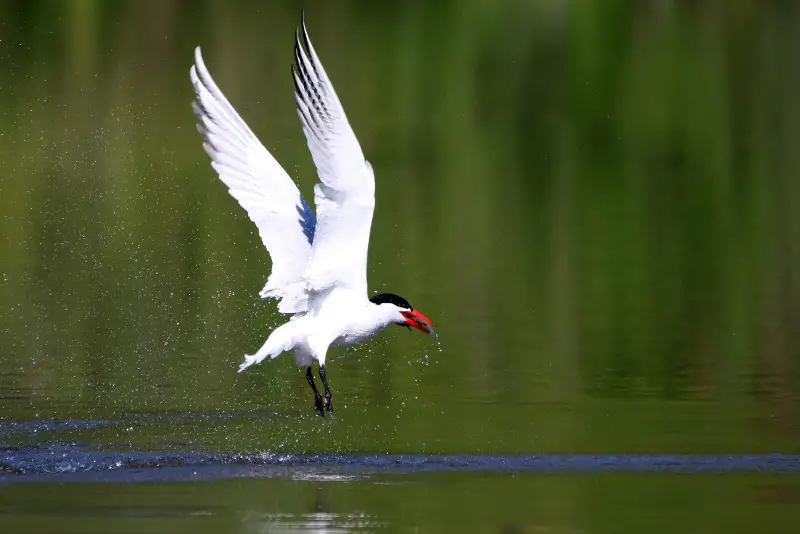
The Caspian tern is the largest tern species in the world, and a rare winter visitor in Florida.
It superficially resembles the Forster’s Tern, but it is a much bigger bird and has a thicker bill, broader wings, and a less forked tail.
Also, during winter the Caspian Tern doesn’t lose its black cap completely, but always retains a streaked, dark crown.
Forster’s Terns, on the other hand, lose their cap entirely during winter, which becomes completely white.
The Caspian Tern is not only a skilled hunter, but this bird also steals food from other terns and gulls. It catches fish by diving into the water with astonishing precision.
The Caspian Tern breeds in freshwater habitats in Canada and northern USA, and winters in the Caribbean and the Gulf of Mexico.
Snowy Egret
Scientific name: Egretta thula
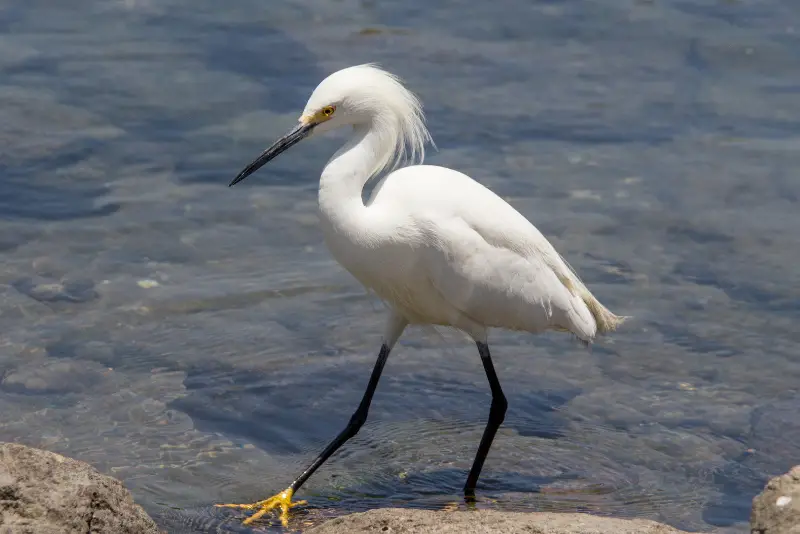
The Snowy Egret has become an increasingly common breeding bird in Florida.
This is due to aggressive conservation efforts that were necessary because this Egret species was systematically hunted in previous centuries.
This white heron stands out due to its slim black bill and bright area between the eyes and nostrils. It has long legs and yellow feet, which distinguish it from other herons.
In adult birds, the feet are a brilliant golden yellow, while the legs are totally black. It is thought that the brightly colored feet help to attract small fish and other prey.
The legs of juvenile birds have a predominant greenish yellow color, with some black areas on the front of the leg.
It is found in practically all types of wetland environments, from small ponds to saltwater and everything in between.
During the summer, the Snowy Egret is a rare to relatively common breeding bird in the state.
It is much more common during the winter months, when large numbers can be observed in coastal Florida.
Common Loon
Scientific name: Gavia immer
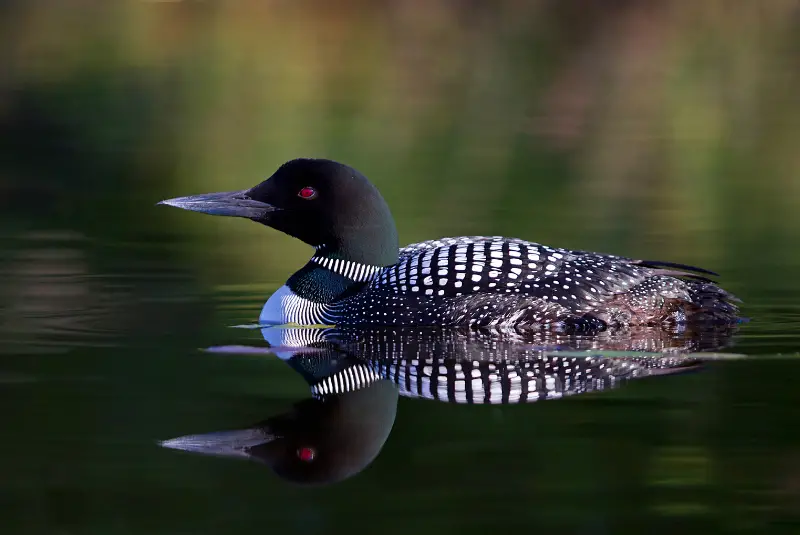
If you spotted a black waterbird with white dots, it is most likely the Common Loon (also known as the Great Northern Diver).
These water birds breed in northern areas of North America and can be seen along the coastline of Florida during the winter.
They have big rounded heads with sharp beaks that resemble a dagger.
In the summer months, the birds have black heads, white chests, and lots of white spots on their black-colored plumage. In the winter or autumn months, their color dulls and turns into a pale gray.
The common loon is a fantastic diver and is super stealthy when it hunts underwater, allowing it to sneak up on fish without even a splash. It can dive to depths of up to two-hundred fifty feet.
To top that off, these birds can stay submerged for up to five minutes and even swallow their prey while they are still underwater.
They have a wingspan of between forty and fifty inches and can live for up to thirty years of age.
Wood Stork
Scientific name: Mycteria americana
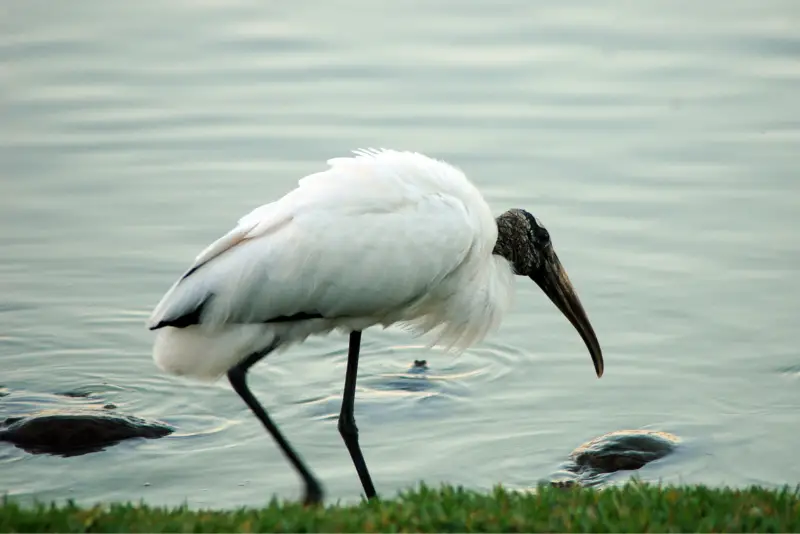
It’s easy to identify a Wood Stork if you can see it up close, due to its entirely white body combined with a bald, black head.
Similar to the White Ibis, the Wood Stork has a bill that curves slightly downwards. However, in contrast to the White Ibis, this bird has a black bill.
While the tail and wing tips are black, this is usually only apparent when you see a Wood Stork in flight.
The Wood Stork is a large bird, similar in size to a Great Egret, but is easily distinguishable from that species by its curved beak.
Unfortunately, Wood Stork populations have been in decline over the past decades, which is a trend that it shares with many other wading birds.
This Florida bird feeds on frogs and other amphibians, fish, and aquatic invertebrates. It likes to nest in big colonies in old trees close to foraging areas.
Whooping Crane
Scientific name: Grus americana
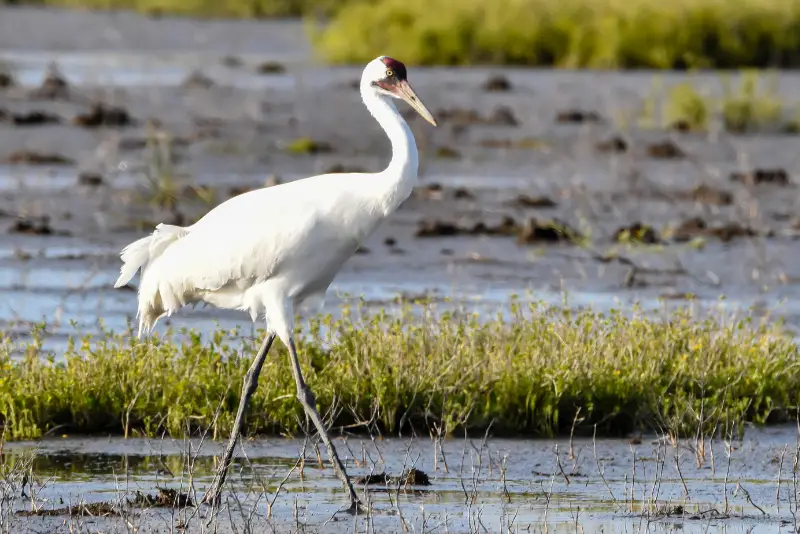
Whooping Cranes are almost 5 feet tall, and are thus the tallest birds in Florida.
The Whooping Crane was almost at the edge of extinction in the 1930s, with less than 20 birds remaining.
However, sustained conservation efforts have brought it back to a current population that numbers 600 birds.
Adult Whooping Cranes have a completely white body, with a red cap that consists of bare skin. In contrast to adults, juvenile birds have a reddish brown color.
Whooping Cranes are found mostly wintering in Florida during the cold season, in mixed flocks with Sandhill Cranes.
However, there is also a non-migratory population of these birds in central Florida that has been introduced. These birds breed from February to May.
During the non-breeding season, the preferred habitat of Whooping Cranes in Florida are swamps, estuaries, and salt flats.
These birds feed mainly on crustaceans and mollusks, with blue crabs making up the largest part of their diet.
While the population of Whooping Cranes has made an amazing comeback from the edge of extinction, it is still a critically endangered species, and in need of continued conservation efforts.
White-tailed Kite
Scientific name: Elanus leucurus

The White-tailed Kite is also known as the Black-shouldered Kite, and both of these are apt names for it.
Adult White-tailed Kites have an entirely white underside, head, and tail. Their upper side is light gray, with dark gray patches on the shoulders. The eyes are deep red.
Juvenile birds, on the other hand, have a more brownish color with light streaks.
White-tailed Kites hunt for small rodents, insects and reptiles in open grassland, either from a perch or on the wing.
Similar to kestrels, these birds like to hover in the air over a specific spot, while waiting for a rodent to come out of its burrow.
White-tailed Kites are scarce breeding residents along the coast of Florida, where these birds can be seen year-round.
Swallow-tailed Kite
Scientific name: Elanoides forficatus
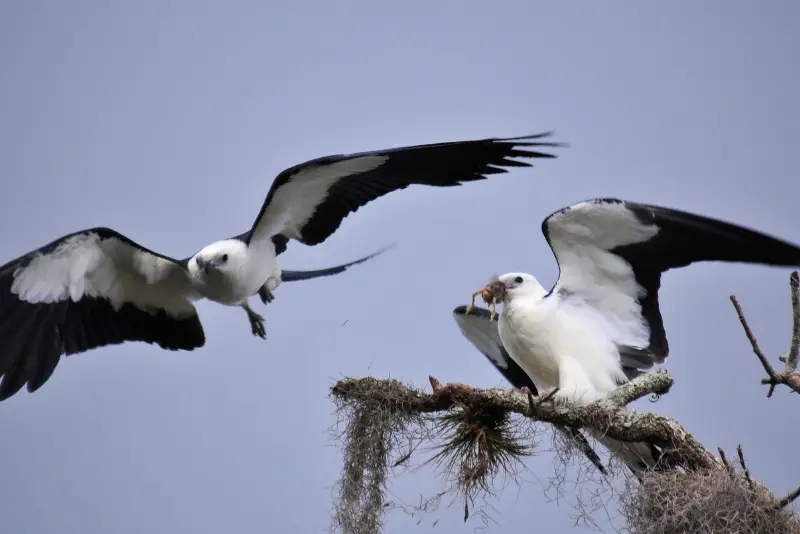
This elegant raptor is easy to identify in flight, due to the combination of its bright white underparts with its deeply forked tail.
The rear margins of the wings and the tail are black. When perched on a tree, its white head and chest contrast with the dark grayish black upperside.
Similar to other kites in Florida, this bird is a skilled hunter and capable of catching insects in flight. Its preferred food are small reptiles, rodents, and insects.
The Swallow-tailed Kite is a summer visitor in Florida, and migrates to Central and South America to spend the winter.
Florida has the largest population of breeding Swallow-tailed Kites in North America.
Great Black-backed Gull
Scientific name: Larus marinus
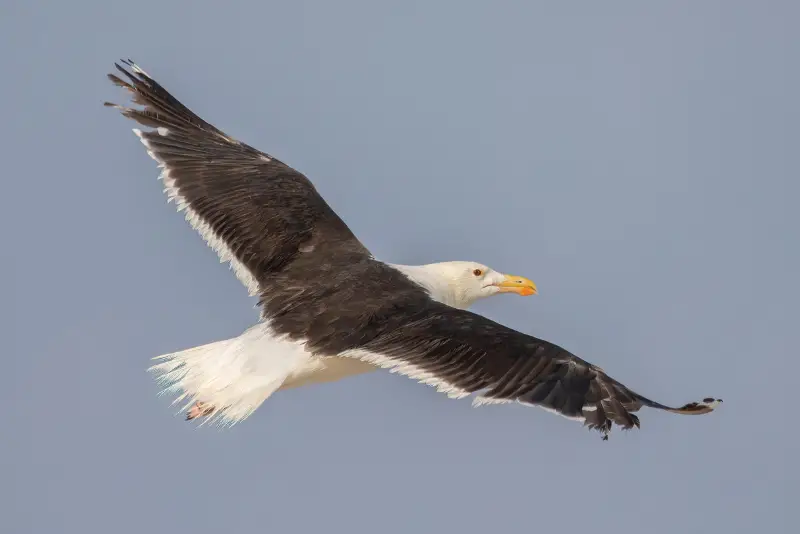
The Great Black-backed Gull is the largest seagull in the world. It is a breeding bird along the northern parts of the East Coast.
This gull is easily recognizable by its huge size and dark blackish gray upperparts, which sets it apart from any other gulls in the area.
Due to its big size, this seagull is able to bully most other seabirds, and does so regularly in order to steal their food.
The Great Black-backed Gull is a rare winter visitor along the eastern coast of north Florida.
This bird used to be an endangered species in previous centuries due to the feather trade, but its population has rebounded, and it is a common sight once more.
Osprey
Scientific name: Pandion haliaetus

The Osprey is one of the largest Florida birds of prey, and with a wingspan of up to 69 inches (5 1/2 feet) it resembles an eagle in size.
It is usually easy to identify the Osprey due white belly and chest, which contrast with its blackish gray upperparts and black wrist patches on its lower wings.
This is the only raptor species in Florida that plunges into the water in order to catch fish, often becoming entirely submerged in water as it attempts to grab a fish with its feet.
Ospreys are almost always found close to water, except during migration, when they will cross areas without water.
It is a common water bird and year-round resident in Florida, where it can be found in both freshwater and saltwater habitats, such as the Florida Keys.
Bald Eagle
Scientific name: Haliaeetus leucocephalus
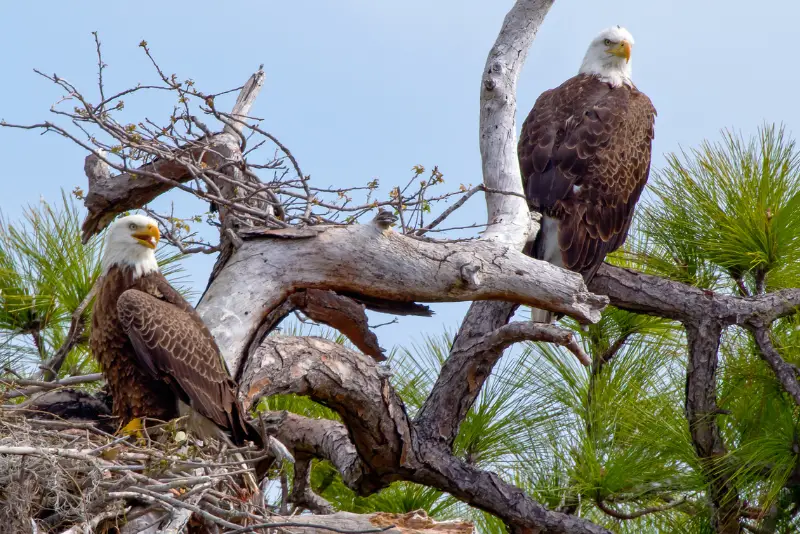
With a wingspan of up to 8 feet, the Bald Eagle is the largest bird of prey in Florida.
Apart from its size, it is also one of the most easily recognizable birds in Florida, due to its white head and tail, which contrast sharply with the uniformly dark brown body.
Juvenile birds are dark brown all over, with light irregular streaks all over the body, as well as a buff white belly.
This huge raptor is a year-round resident found throughout Florida, although it isn’t common anywhere in the state.
Bald Eagles spend a lot of their time soaring on thermal currents with their wings held flat. They feed on fish, birds, and small mammals, although a large part of their diet consists of carrion.
Turkey Vulture
Scientific name: Cathartes aura
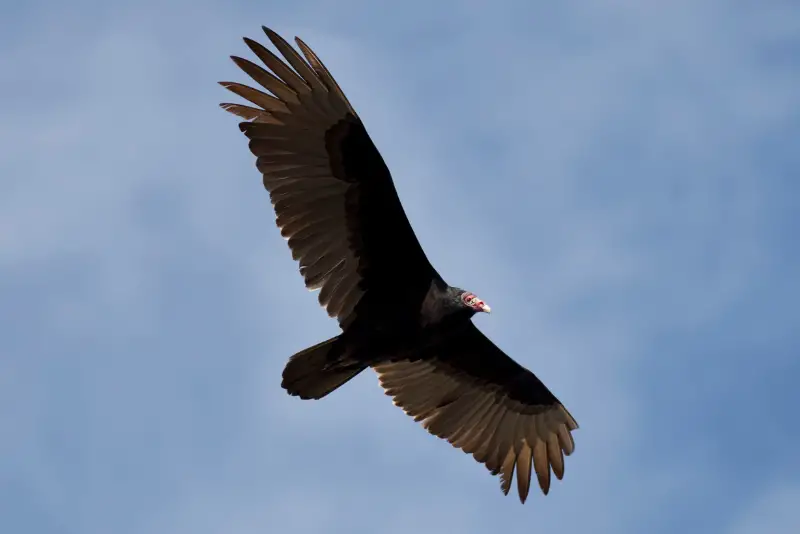
The Turkey Vulture is the largest vulture species in Florida, and can reach a wingspan of up to 6 feet.
It is a large black raptor with a naked head, and dark gray rear margins on their wings, which can be seen in flight.
A soaring Turkey Vulture is easily identifiable due to the fact that it holds its wings in an upright V shape.
This bird is a year-round resident throughout the Florida peninsula, where it favors open country interspersed with woodland.
Similar to other vulture species in Florida, this bird is specialized in feeding on carrion, and will often congregate in flocks around roadkill.
Great Horned Owl
Scientific name: Bubo virginianus

The Great Horned Owl is the largest owl species in Florida, with a wingspan up to 4 feet. It is a large rufous brown bird with two horns and big bright yellow eyes.
In Florida, this owl starts its nesting very early in the year, laying its eggs in January or February.
It is almost entirely nocturnal, and can hunt in complete darkness by relying on its keen sense of hearing.
The Great Horned Owl doesn’t build its own nest, but instead occupies the nests of other large birds, such as herons or birds of prey.
It is found year-round throughout Florida, and can be found in a wide variety of habitats in Florida, from woodlands to urban areas.
This owl is a fierce hunter, catching birds up to the size of ducks, and mammals up to the size of foxes.
Red-tailed Hawk
Scientific name: Buteo jamaicensis
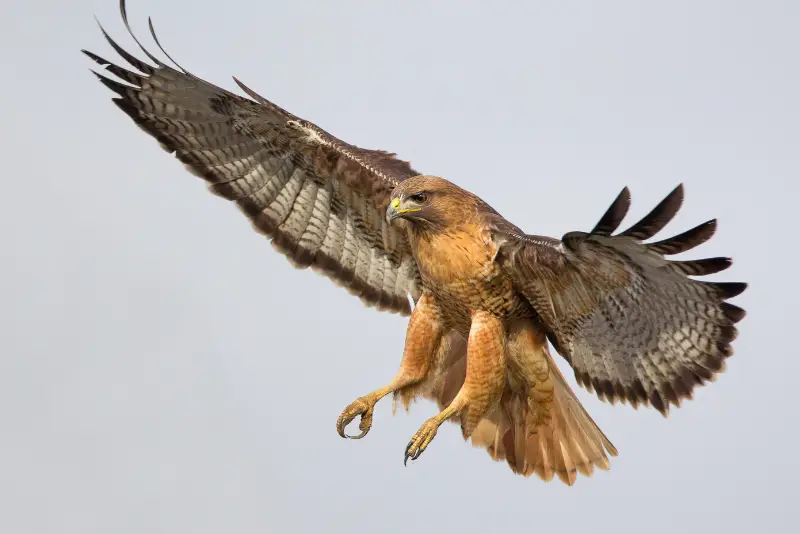
With a wingspan of up to 52 inches (4 1/2 feet), the Red-tailed Hawk is the largest hawk species in Florida.
It has variable coloration, ranging from dark brown to almost entirely white, but can be readily recognized by its rusty red tail.
This large hawk is common in open areas and even in cities. It is most often seen perched on roadside posts or fences, waiting for prey.
The Red-tailed Hawk is a common year-round resident in Florida, except for the tip of southern Florida, where it only occurs during winter.
It feeds on rodents and other small animals that it catches by swooping down from its perch when they venture out into the open.
What are the large black birds in Florida?
The large black birds found in Florida are Turkey Vultures, which have a wingspan up to 6 feet.
These black-colored vultures are commonly seen in Florida soaring on thermal currents, or gathering in small groups at roadkill sites.
Another Florida bird that’s large and black is the American Crow, which is common throughout the state. However, with a wingspan under 4 feet, it is significantly smaller than the Turkey Vulture.
What is the largest bird in Florida?
The largest bird in Florida is the American White Pelican, which has a wingspan of up to 10 feet (120 inches) and a weight of up to 30 lb. It also has a huge beak, measuring up to 15 inches in length.
In spite of its large body weight, the American White Pelican is able to soar effortlessly on thermal currents, due to the enormous length of its wings.
The best place to see these birds in Florida is at Pelican Island National Refuge, where they congregate in big groups during the winter months.


